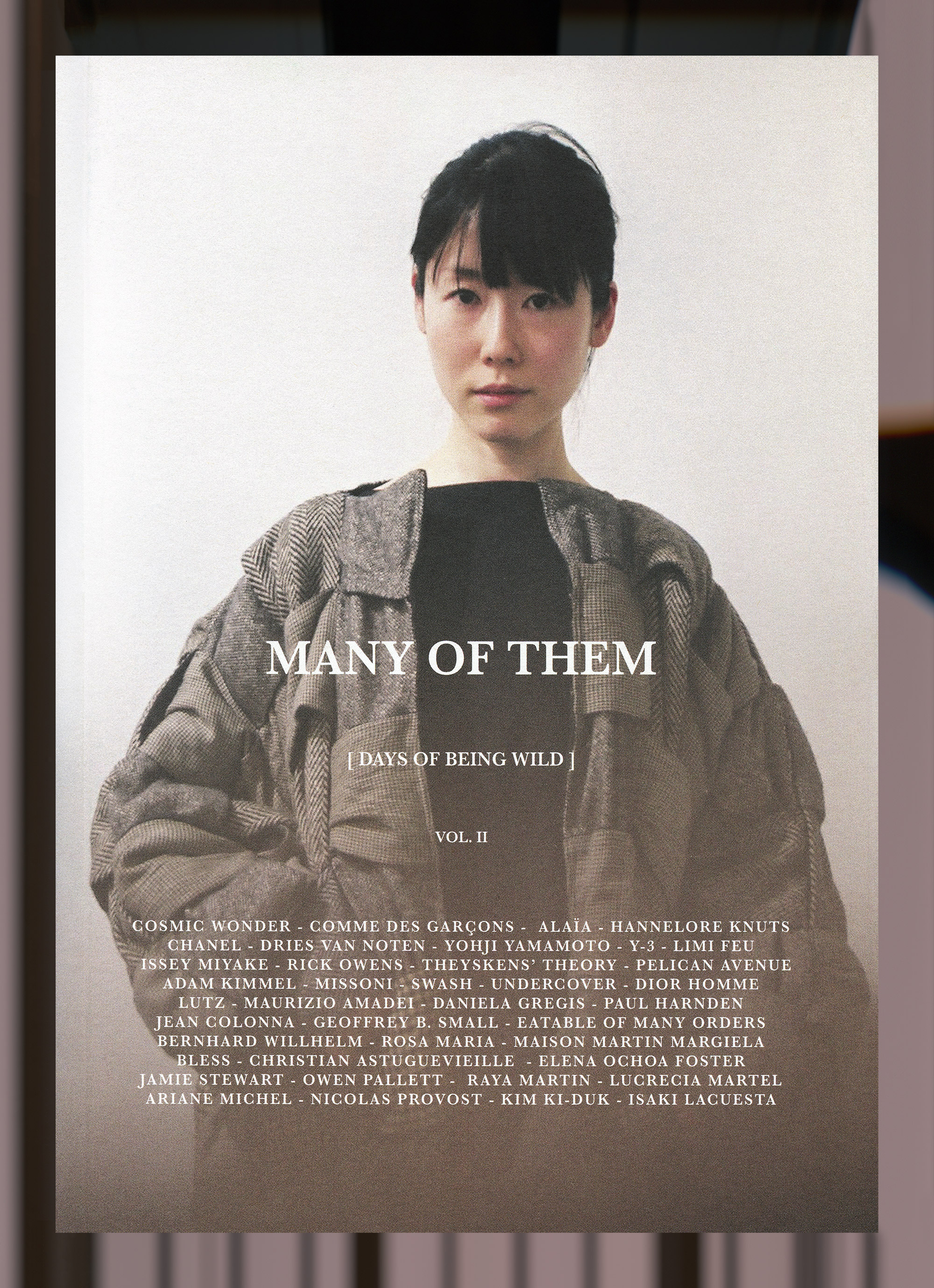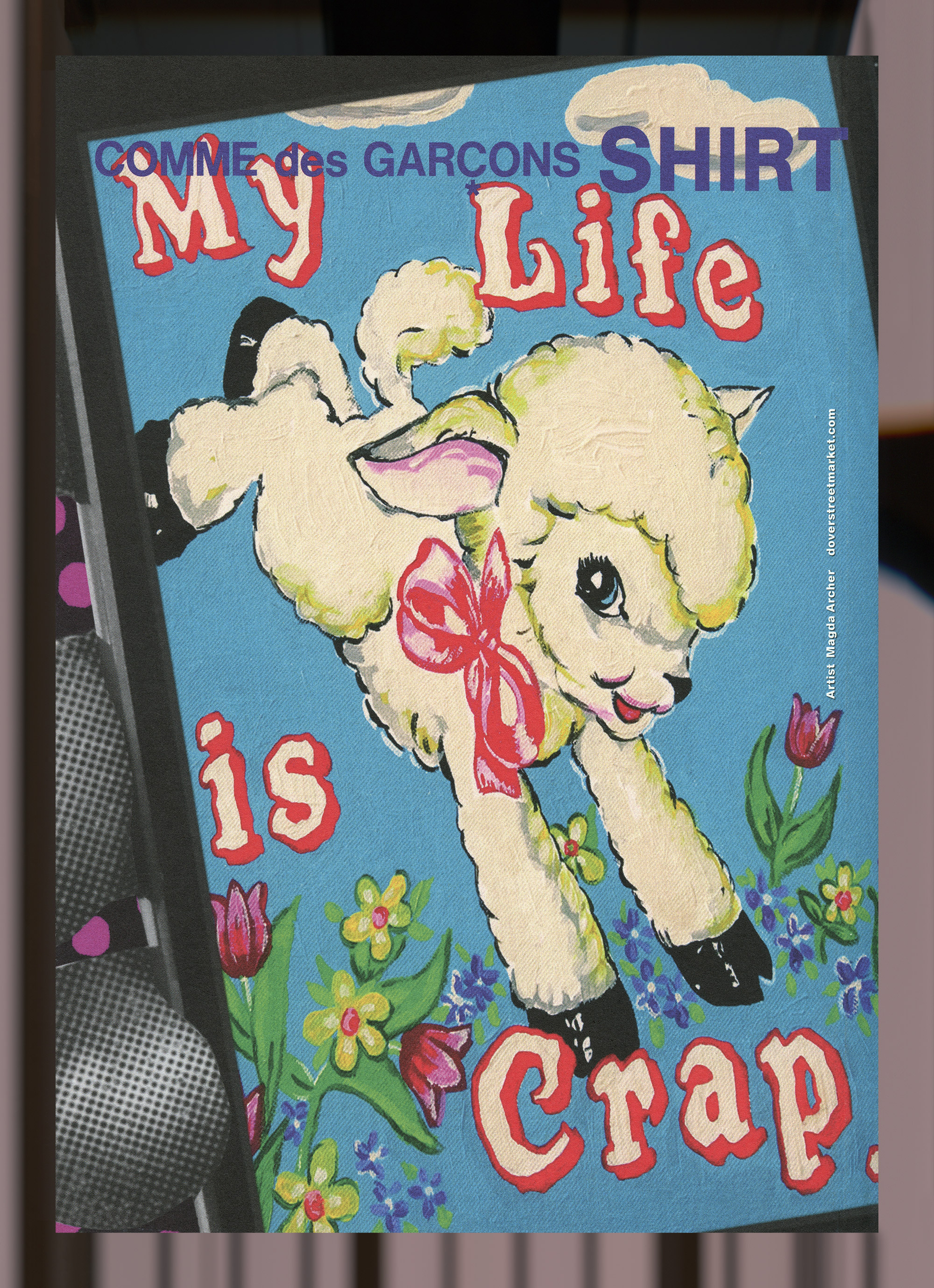MANY OF THEM [issue] #2 [title] DAYS FOR BEING WILD – 35,00 € - SOLD OUT
35,00 € – SOLD OUT ︎

In Issue #2 of MANY OF THEM Belgium model and actress HANNELORE KNUTS explains her role in The Invader—video artist NICOLAS PROVOST’s last film—while beign photographed in ALAÏA’s Fall 2011 collection. DRIES VAN NOTEN reveals how most of his inspirations come from other cultures, rituals and traditions, and delves into how the biggest developments in the fashion industry have been globalization and the Internet. From her studio in Tokyo, LIMI YAMAMOYO recalls her father’s first words after her debut collection, “Welcome to hell!”, and expands on the importance of designing clothes for real women unlike him. The head of womenswear at ISSEY MIYAKE, YOSHIYUKI MIYAMAE, discuses how the Pakipodiumu plant was a source of inspiration for his Spring 2012 collection and tells that merging state–of–the–art methods with traditional procedures in the pursuit of creating clothes suits the company’s current mindset. On 4th March, DAI FUJIWARA writes a goodbye letter as he steps down from his position of creative director at ISSEY MIYAKE and evaluates his contribution to how his team could take Mr. MIYAKE’s core concept of A Piece of Cloth on to the next stage and adapt it for the next generation. Founder of PELICAN AVENUE, CAROLIN LERCH, discloses that the only way to stand up against the big industries is to make something really personal and explains how her last collection Itobia emerged from her strong snake phobia. Talking about his firts show in Paris, American menswear designer ADAM KIMMEL how while he was studying tailoring and pattern cutting in Italy he put together a small collection and SARAH ANDELMAN, from Colette, bought it and gave him his start. The team behind SWASH, SARAH SWASH and TOSHIO YAMANAKA,exponds on the idea that even though most prints out there tend to be digital, they keep creating them by hand, and share their appreciation for people who buy a product thinking of it as a piece that goes far beyond the idea of seasons to become something they would have in their wardrobes forever. Not far from there, from the same arrondisement in Paris, LUTZ HUELLE claims he has always been more interested in popular culture than clothing because it defines our times and asserts that it’s not possible for strong statements like the one made by MARTIN MARGIELA to arise now because everything has to fit into some wider context straight away. Italian designer DANIELA GREGIS reflects on how big Italian companies don’t invest in research anymore and explains on our need to rediscover our relationship with land and with the most essential things because we are getting lost. “Basically, my new work shapes a continuos story far from usual fashion structure based on the newness”, declares JEAN COLONA while remembers how he restarted his project in 2002 in which the main idea wasn’t to create new items every six months. COLONA also states how promoting things as being handmade is just a marketing strategy to sell bags. By composing an essay titled Made in Italy, GEOFFREY B SMALL delves into his experience with the Italian fashion industry and remarks on his involvement to raise awareness on the nuclear problem and the need to reduce the impact of the carbon footprint. Designer duo KOJI and YOKO ARAI, from the Japanese label EATABLE OF MANY ORDERS, chat about how the name of the brand is inspired by KENJI MIYAZAWA’s Restaurant of Many Orders, a story about a cat in a restaurant who gives orders to costumers, and also argues how Japan doesn’t have a very long fashion history but a great capacity to learn and improve as an industry. From her studio in Beirut, jeweller ROSA MARIA ARBOROUS recounts how the accessory industry is very strong right now because clothing is losing a lot of power and goes through The Kimberly Process and its goal to stop buying blood diamonds, that are suspected of supporting wars, crime organizations and terrorism. The forces behind BLESS, INES KAAG and DESIREE HEISS, open up about their latest collection Nº 43 Know Howowow, and describe how they decided to invite art and fashion students to the presentation in the town house, in order to draw the models in detail to depict the collection only through them. To finish, COMME DES GARÇONS’ perfumes creative director, jeweller and artist CHRISTIAN ASTUGUEVIEILLE declares that because of his pedagogical studies he wanted to direct his work towards the sensory and believes how even he thought he had met REI KAWAKUBO by chance, after seventeen years of working together he can say that chance does not exist in her life.
Opening the frame, MANY OF THEM review the work from other disciplines like edition, curation, film, music and art like; Spanish publisher and art curator ELENA OCHOA FOSTER discusses the production of How Much Does Your Building Weight, Mr. Foster?, and explains why for her the idea of making documentaries and artists books is very similar; portraying people who have transformed reality in the world of art and other disciplines. Xiu Xiu founder JAMIE STEWART illustrates how music began to feel more real once he started his band and reports that its point is to try to go further than it feels comfortable to go. Musician OWEN PALLETT speaks about how he was reading HERMAN MELVILLE when writing his album Heartland and finds that the setting of Moby Dick and its philosophical notions did leak a little bit into the material he was working on. Artist and filmmaker RAYA MARTIN confers about his first movie not shot in the Philippines, Buenas noches, España, whose aim is to make the traditional idea of history and politics more accessible for people his age, and reflects on how his work is about documenting, not in the classical sense, but using the concept in a way to capture a certain ideology or contemporary mind-set. From her studio in Buenos Aires, LUCRECIA MARTEL uncovers her thoughts and actions previous to making her films, understanding reality as a conspiracy and not as something constituted, and also articulates on how people want further definition in film, but the expressive side of the image is not related to definition. Les Hommes director, ARIANE MICHEL, recalls on how she got the chance to discover the mechanisms for creating fiction and its ability to change reality when she worked with her friend ÉMILIE DELEUZE, the daughter of the French philosopher GILLES DELEUZE. Video artist and filmmaker NICOLAS PROVOST, pronounces his film The Invader could have been seen as racist because its plot is about how we project the monster of the immigrant, and wonders about how film language can still surprise audiences today. KIM KI-DUK talks about his first movie made in Europe, Amen, and how he wants to transmit the message that any person can make a film without money, without any technical team and without any special camera. Lastly, ISAKI LACUESTA discusses how his film Los Pasos Dobles is close to the spirit of JEAN ROUCH and focuses on the lack of transitions or moments of emptiness that are usually criticised in art films.
Plus, folders exploring three unique fashion specials: COSMIC WONDER LIGHT SOURCE shot by ANDERS EDSTRÖM in Kyoto with KEIKO MAEDA, WILLIE BROWN, KIGI HINOKI, KEISUKE SUGIMOTO, model and musician ELEONORA SALVATORE is photographed in DIOR HOMME’s Spring 2012 collection by KRIS VAN ASSCHE and Filipino director RAYA MARTIN reviews the most iconic items by MAISON MARTIN MARGIELA.
Within the issue multiple fashion stories were created in collaboration with, COSMIC WONDER, COMME DES GARÇONS, ALAÏA, CHANEL, DRIES VAN NOTEN, YOHJI YAMAMOTO, Y-3, LIMI FEU, ISSEY MIYAKE, RICK OWENS, THEYSKEN’S THEORY, PELICAN AVENUE, ADAM KIMMEL, MISSONI, SWASH, UNDERCOVER, DIOR HOMME, LUTZ, MAURIZIO AMADEI, DANIELA GREGIS, PAUL HARNDEN, JEAN COLONNA, GEOFFREY B. SMALL, EATABLE OF MANY ORDERS, BERNHARD WILLHELM, ROSA MARIA, MAISON MARTIN MARGIELA and BLESS.
392 pages, 215 x 155 x 35 mm, softcover, printed in Spain, 2012.

Cover, DANIELLA GREGIS. Brown wool patchwork coat, DANIELA GREGIS. Photography, ANTONIO MACARRO. Styling, PEDRO CANICOBA. Model, YUI TANAKA. These DANIELA GREGIS pieces were photographed on Tuesday, March 3rd of 2009, in Paris, France

Back cover, COMME DES GARÇONS. Artwork by MAGDA ARCHER for Spring 2012 campaign